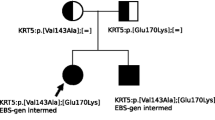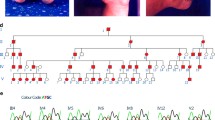Abstract
Recent advances in molecular biology have enabled the association of epidermolysis bullosa simplex (EBS) with point mutations of keratin 14 and/or keratin 5 genes to be established. We describe here the detection of point mutations in genomic DNA from formalin-fixed and paraffin-embedded sections from five cases of epidermolysis bullosa using the PCR amplification of specific alleles (PASA) method. In two of four cases of Köbner-type EBS a point mutation of helix 2b (384 Leu-Pro) was detected and in one case of Dowling-Meara-type EBS a mutation in helix 1a (125 Arg-Cys) was detected. The results of this study are consistent with previous reports and they demonstrate that the PASA method is a rapid and reproducible method for the detection of single-base changes and small deletions.
Similar content being viewed by others
References
Albers K, Fuchs E (1989) Expression of mutant keratin cDNAs in epidermal cells reveals possible mechanisms for initiation and assembly of intermediate filaments. J Cell Biol 108: 1477–1493
Anton-Lamprecht I, Schnyder UW (1982) Epidermolysis bullosa herpetiformis Dowling-Meara: report of a case and pathomorphogenesis. Dermatologica 164: 221–235
Bonifas JM, Rothman AL, Epstein EH (1991) Epidermolysis bullosa simplex: evidence in two families for keratin gene abnormalities. Science 254: 1202–1205
Chan YM, Yu QC, Fine J-D, Fuchs E (1993) The genetic basis of Weber-Cockayne epidermolysis bullosa simplex. Proc Natl Acad Sci USA 90: 7414–7418
Cooper T, Bauer EA (1984) Epidermolysis bullosa: a review. Pediatr Dermatol 1: 181–188
Coulombe PA, Hutton ME, Letai A, Hebert A, Paller AS, Fuchs E (1991) Point mutations in human keratin 14 genes of epidermolysis bullosa simplex patients: genetic and functional analyses. Cell 66: 1301–1311
Dong W, RyynÄnen M, Uitto J (1993) Identification of a leucine-to-proline mutation in the keratin 5 gene in a family with the generalized Köbner type of epidermolysis bullosa simplex. Hum Mutat 2: 94–102
Fine J-D (1986) Epidermolysis bullosa: clinical aspects, pathology, and recent advances in research. Int J Dermatol 25: 143–157
Fine J-D, Bauer EA, Briggaman RA, Carter DM, Eady RAJ, Esterly NB, Holbrook KA, Hurwitz S, Johnson L, Lin A, Pearson R, Sybert VP (1991) Revised clinical and laboratory criteria for subtypes of inherited epidermolysis bullosa. J Am Acad Dermatol 24: 119–135
Haneke E, Anton-Lamprecht I (1982) Ultrastructure of blister formation in epidermolysis bullosa hereditaria: V. Epidermolysis bullosa simplex localisata type Weber-Cockayne. J Invest Dermatol 78: 219–223
Humphries MM, Sheils DM, Farrar GJ, Kumar-Singh R, Kenna PF, Mansergh FC, Jordan SA, Young M, Humphries P (1993) A mutation (Met-Arg) in the type I keratin (K14) gene responsible for autosomal dominant epidermolysis bullosa simplex. Hum Mutat 2: 37–42
Lane EB, Rugg EL, Navsaria H, Leigh IM, Heagerty AHM, Ishida-Yamamoto A, Eady RAJ (1992) A mutation in the conserved helix termination peptide of keratin 5 in hereditary skin blistering. Nature 356: 244–246
Lazarides E (1980) Intermediate filaments as mechanical integrators of cellular shape. Nature 283: 249–258
Letai A, Coulombe PA, McCormick MB, Yu QC, Hutton E, Fuchs E (1993) Disease severity correlates with position of keratin point mutations in patients with epidermolysis bullosa simplex. Proc Natl Acad Sci USA 90: 3197–3201
Pearson RW, Spargo B (1961) Electron microscope studies of dermal-epidermal separation in human skin. J Invest Dermatol 36: 213–224
Ryynanen M, Knowlton RG, Uitto J (1991) Mapping of epidermolysis bullosa simplex mutation to chromosome 12. Am J Hum Genet 49: 978–984
Saiki RK, Gelfand DH, Stoffel S, Scharf SJ, Higuchi R, Horn GT, Mullis KB, Erlich HA (1988) Primer-directed enzymatic amplification of DNA with a thermostable DNA polymerase. Science 239: 487–491
Sommer SS, Groszbach AR, Bottema CDK (1992) PCR amplification of specific alleles (PASA) is a general method for rapidly detecting known single-base changes. Biotechniques 12: 82–87
Vassar R, Coulombe PA, Degenstein L, Albers K, Fuchs E (1991) Mutant keratin expression in transgenic mice causes marked abnormalities resembling a human genetic skin disease. Cell 64: 365–380
Author information
Authors and Affiliations
Rights and permissions
About this article
Cite this article
Hachisuka, H., Morita, M., Karashima, T. et al. Keratin 14 gene point mutation in the Köbner and Dowling-Meara types of epidermolysis bullosa simplex as detected by the PASA method. Arch Dermatol Res 287, 142–145 (1995). https://doi.org/10.1007/BF01262322
Received:
Issue Date:
DOI: https://doi.org/10.1007/BF01262322




